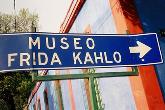| SOUNDTRACK SCREENPLAY DOWNLOADS SCREENINGS DVD |  |
|
|
 |
 |
 |
 |
 |
 |
|
||||||
|
Mexico The Critic The Rivera Murals The Casa Azul Jet-lag Festival Screening The Trotsky Museum Exile Profound Mexico Hope Rain on canvas The Jury The Anthropological Museum Time Political Correctness Two Houses False Virtue Life is a miracle Weird Roots The Meeting Turtles Can Fly The Oscars Luis Barragans house Back to Diary Index |
The Casa Azul We take a break to eat some delicious fish in a café near Frida Kahlo’s house (the ‘Casa Azul’ or ‘Blue House’). Everywhere in Mexico City you feel the presence of colour. You can even see it from the air when flying in; houses painted yellow, orange, red, blue, little glowing blocks of pigment. We are not allowed to take cameras into Frida Kahlo’s house, so I photograph parts of the exterior wall, which weather and age has rendered beautiful. Looking at Frida Kahlo’s work so soon after being immersed in Rivera’s murals, and knowing something of her political sensibilities and awareness, it seems more vividly than ever that she channels not just her own personal pain but also the pain of her country into her work. She becomes Mexico itself in her self-portraits; a country with a broken spine; the smashed columns of Aztec temples, the ruins of a once-splendid culture with which she identified. Cutting her hair off, losing a leg, her body violated by surgery, each becomes an image evoking the rape of conquest, a broken state, blood on the earth. ‘Metaphor’ is too cool, too imprecise a word for the layering of meanings embodied in the images. Where Rivera chronicled and made visible the historical ‘facts’ (albeit from a very particular and sometime didactic point of view) she created a mythology based on her own truth, a self portrait which was also a portrait of a suffering nation. (Which is not to say, as I later discover, that the Aztecs and Mayans were all peace-loving peoples; there were wars, conflicts, and human sacrifices.) The most telling objects in her house for me were not the familiar body-casts and the wheelchair placed in front of an easel; but the display of ‘votivos ’ on the walls of a staircase. These tiny ‘naïve’ religious paintings, made as offerings for healings, often portray someone lying sick in bed being visited by an angel. The use of an emotional rather than a realistic visual scale, with objects and people larger than life-size if they were significant to the painter, clearly deeply influenced both Kahlo and Rivera’s work. The feeling for the miraculous, for the unseen forces at work in life and death, later claimed by the surrealists and all but obliterated in cinema in the name of realism, is vividly present in the Casa Azul. In response to a question (about the nightmarish quality of some of her work) Frida apparently once said she didn’t paint her dreams, she painted her life. back next |
  SP outside Casa Azul  The blue wall |
||||
Text © Sally Potter. All pictures © Adventure Pictures unless otherwise indicated |